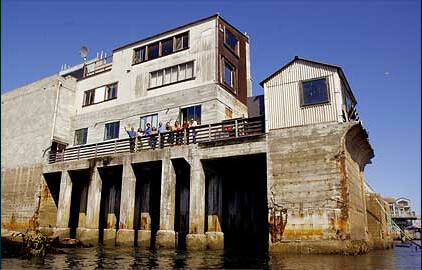Mark Shelley (Executive Director) checking in today from New Haven, Connecticut, where I will be on a panel with other environmental media producers at the Yale Institute for Biospheric Studies. The panel is going to discuss the problems we face in bringing good environmental science in the mass media-- and why there isn't more/better coverage of environmental science.
I'm going to show a short segment from Strange Days that worked well with audiences and shows one way we've tackled the challenge. But it also helps question of why we don't see more/better environmental science coverage: the simple answer is because it's hard to do well. This sequence I'll show was one of the most difficult for us to produce. It involved atmospheric modeling that is trying to simulate and predict the effects of CO2 on major global weather patterns. Mathematical modeling has been a taboo for most television broadcasting as being to nerdy, boring, esoteric. It seems that modeling represents all that is horrible in people's minds about bad science classes (it is both science AND math-- ouch). So we boldly took it on for a couple of reasons: they are critical in our ability to evaluate our role in affecting climate (and other systems), they can provide scientific veracity to the naysayers of climate change, they can help to predict how we need to react and prepare for the future scenarios, and they can be incredibly cool and visually interesting. Here is the sequence:
The sequence ended up working well with audiences, and helped literally tens of millions of people worldwide understand why climate change has the potential to create all kinds of problems for us we might never have imagined. But making that sequence work wasn't easy.
In trying to communicate any environmental science issue, we know from research that it's important to help audiences put complex information into a bigger context. Our role is to turn science into story-- to convey the information in ways that help people connect the dots, to make sense of the details, to help see why the science matters. And doing that right requires navigating a minefield between concepts and what comes out the tv screen. And it involves working with a huge number of players-- funders, production partners, advisory board members, audience research, producers, the scientists, writers, editors, and finally the broadcasters themselves. In every step, we are trying to protect the original concept and take the elements from each that will enhance that concept. As much as I don't like sports analogies, it is much like carrying the football from your one yard line. In this game, however, the defenders want to change the ball, add stuff to it, and in some cases, even take it away. By the time you get over the goal, you hope that what you were carrying is in some way reflective of the ball that you had way back when you started.
That process for Strange Days took three years and an awful lot of money. But when it was delivered, we had the opportunity to present four hours of good environmental science to those millions of people. And we even got away with one very complex atmospheric model.
Wednesday, May 2, 2007
At Yale's Institute for Biospheric Studies
Labels:
Connecticut,
Mark Shelley,
Strange Days on Planet Earth,
Yale
Subscribe to:
Post Comments (Atom)


No comments:
Post a Comment